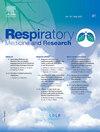Phenotypes and prognosis of systemic sclerosis: A cluster analysis
IF 1.8
4区 医学
Q3 RESPIRATORY SYSTEM
引用次数: 0
Abstract
Introduction
Systemic sclerosis is a complex autoimmune disease with significant morbidity and mortality, primarily due to pulmonary complications, including diffuse interstitial lung disease and pulmonary hypertension. The disease course is unpredictable due to its heterogeneous presentation. Our study aimed to form homogeneous cohorts of patients with severe visceral systemic sclerosis and assess their prognoses.
Materials and methods
We conducted a single-center retrospective observational study on 198 patients. These patients were clustered based on factors associated with poor disease prognosis using a bottom-up hierarchical clustering technique.
Results
We identified four clusters in our population. Cluster 1 (n = 25) included 89 % of patients with pulmonary hypertension, 64 % of whom had associated interstitial lung disease. Cluster 2 (n = 11) included all patients with scleroderma renal crisis, 27 % of whom developed pulmonary hypertension. Cluster 3 (n = 109) exclusively consisted of female patients, 90 % of whom had a limited cutaneous form, with 62 % presenting anticentromere antibodies. These patients did not exhibit severe pulmonary disease. Cluster 4 (n = 53) included patients with significant occupational exposure, 79 % of whom had diffused interstitial lung disease and 83 % had anti-topoisomerase I antibodies. The survival rate was significantly lower in cluster 1 (p < 0.001).
Conclusion
This study characterized systemic sclerosis phenotypes, highlighting the heterogeneity in clinical presentation and disease course. The trajectory of patients within each cluster was associated with the onset of pulmonary hypertension onset, which adversely affected the prognosis.
系统性硬化症的表型和预后:聚类分析
系统性硬化症是一种复杂的自身免疫性疾病,发病率和死亡率很高,主要是由于肺部并发症,包括弥漫性间质性肺疾病和肺动脉高压。由于其异质表现,病程难以预测。我们的研究旨在形成严重内脏系统性硬化症患者的同质队列并评估他们的预后。材料与方法对198例患者进行单中心回顾性观察性研究。采用自下而上分层聚类技术,根据与疾病预后不良相关的因素对这些患者进行聚类。结果我们在人群中确定了四个群集。第1组(n = 25)包括89%的肺动脉高压患者,其中64%的患者伴有间质性肺疾病。第2组(n = 11)包括所有硬皮病肾危象患者,其中27%发生肺动脉高压。第3组(n = 109)完全由女性患者组成,其中90%有有限的皮肤形式,62%出现抗着丝粒抗体。这些患者没有表现出严重的肺部疾病。第4组(n = 53)包括有明显职业暴露的患者,其中79%患有弥漫性间质性肺病,83%有抗拓扑异构酶I抗体。第1组的存活率明显较低(p <;0.001)。结论本研究具有系统性硬化症的表型特征,突出了临床表现和病程的异质性。每组患者的发展轨迹与肺动脉高压的发病相关,这对预后有不利影响。
本文章由计算机程序翻译,如有差异,请以英文原文为准。
求助全文
约1分钟内获得全文
求助全文
来源期刊

Respiratory Medicine and Research
RESPIRATORY SYSTEM-
CiteScore
2.70
自引率
0.00%
发文量
82
审稿时长
50 days
 求助内容:
求助内容: 应助结果提醒方式:
应助结果提醒方式:


